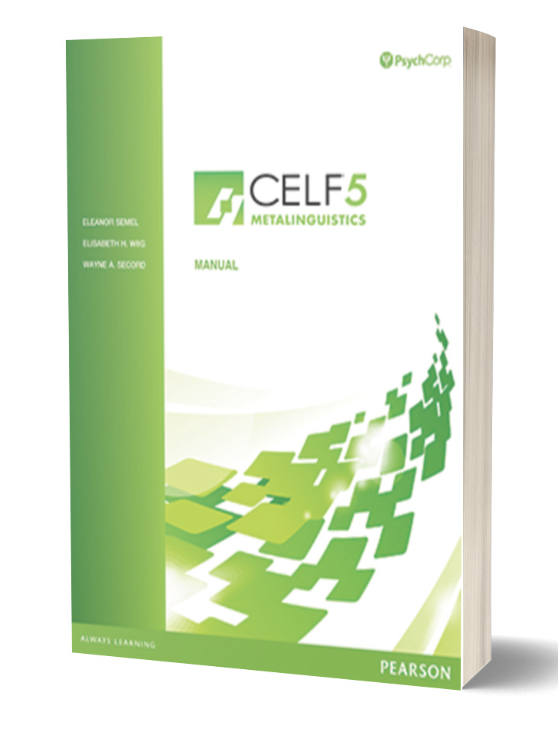Giving the Clinical Evaluation of Language Fundamentals- 5th Edition Metalinguistics (CELF-5 Meta)
The Clinical Evaluation of Language Fundamentals-5th Edition Metalinguistics (CELF-5 Meta) is a standardized measure that is administered to measure a client’s ability to analyze, talk about, and think about language independent of the concrete meaning of the word, phrase, or sentence in comparison to other children of the same chronological age. The CELF-5 Meta is for children ages 9-21 years.

The CELF-5 Meta came out in 2014 but I am new to this test and I love it! Let’s face it, it’s just difficult to measure social language skills. Testing isn’t always natural, ok it’s not natural at all. However, the CELF-5 Meta gives evaluators an opportunity to measure the client’s ability to understand language that is used in social contexts and obtain standard scores. Also, like the CELF-5, this test can also be given online through Q Global, making it super convenient to give anywhere.
Just like with the CELF-5, SLPs who administer the CELF-5 Meta should be familiar with the client’s background and linguistic differences such as dialectal variations or English as a second language as these variations can negatively impact the client’s scores. Social norms and figurative language vary drastically across cultures.
CELF-5 Meta Areas of Assessment
The CELF-5 Meta includes the following subtests for ALL ages:
- Metalinguistics Profile: An optional norm-referenced rating scale for caregivers or teachers to rate a child’s metalinguistic skills in everyday educational and social contexts.
- Making Inferences: Evaluates the ability to identify and formulate logical inferences on the basis of existing causal relationships or event chains.
- Conversation Skills: Evaluates the ability to initiate a conversation or respond in an appropriate way and incorporate given words into meaningful and grammatically correct sentences.
- Multiple Meanings: Evaluates the ability to recognize and interpret different meanings of selected words and sentence-level ambiguities.
- Figurative Language: Evaluates the ability to interpret figurative expressions (idioms) within a given context and match each expression with another figurative expression of similar meaning.
Scoring the CELF-5 Meta
The evaluator completes all sections of the assessment. Directions are given for each subtest as well as the basal and ceiling (where to start and end). The evaluator then calculates the client’s correct responses for each subtest and uses the manual to obtain a scaled score.
The subtest scaled scores are combined and transferred to composite quotients, which gives a more reliable assessment of the child’s ability of overall meta-pragmatic and meta-semantic language skills. The composite quotients are as follows:
- Total Metalinguistics Index: Measures overall metalinguistic abilities
- Meta-Pragmatics Index: Measures the ability to initiate conversation and generate appropriate responses based on communicative demands of a situation
- Meta-Semantics Index: Measures the ability to understand and interpret abstract, figurative language
These composite quotients correlate to a rating of above average, average, borderline, low, or very low.

Borderline Language Skills
Children with borderline social language skills may demonstrate some challenges in using or understanding language in social contexts. Clients may have difficulty initiating and maintaining conversations with new people, taking turns appropriately in conversation, and staying on topics that are not of interest to them. They might struggle with understanding and using subtle nonverbal cues, such as facial expressions and body language. They may exhibit some difficulty adapting their language style and content to different social situations, such as conversing with peers vs. teachers, and may need support to navigate social interactions effectively.
Low-Level Language Skills
Children with low-level social language skills may experience difficulties in using and understanding language in social settings. They may have difficulty recognizing and responding to others’ emotions, intentions, and perspectives. Clients may exhibit limited awareness of conversational rules and may struggle to participate in group discussions or play activities. They may require explicit instruction and guidance to develop social communication skills.
Very Low-Level Language Skills
Children with very low-level social language skills may have significant difficulties in using language appropriately in social interactions. They may have significant difficulty engaging in reciprocal conversations and turn-taking. For example, they may revert topics of conversation back to their own interests, interrupt speakers, or not make follow-up questions or statements to maintain a conversation. They may have a limited understanding of social cues and may not recognize or appropriately respond to others’ emotions, intentions, or social norms. They may also have difficulty inferring information from context clues, reading nonverbal cues, and understanding figurative language.
For more info on report writing, check out these resources- ⬇️
Blog post: Write a Great Speech and Language Report
FREE course: Write Speech and Language Reports Like a Boss
Blog post: Giving the Functional Communication Profile
